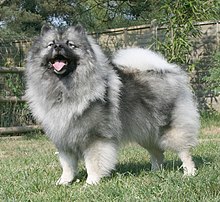This article needs additional citations for verification. (May 2007) |
| Keeshond | |||||||||||||||||||||||
|---|---|---|---|---|---|---|---|---|---|---|---|---|---|---|---|---|---|---|---|---|---|---|---|
 Distinct characteristics of Keeshonden include a lion-like ruff, spectacles, small and dark triangular ears, definite contrast, and a thick double coat. | |||||||||||||||||||||||
| Other names | Dutch Barge Dog, Smiling Dutchman, German Spitz, Deutscher Wolfspitz, Wolfspitz, Dire Pomeranian | ||||||||||||||||||||||
| Common nicknames | Kees | ||||||||||||||||||||||
| Origin | Netherlands | ||||||||||||||||||||||
| |||||||||||||||||||||||
| |||||||||||||||||||||||
| Dog (domestic dog) | |||||||||||||||||||||||
The Keeshond (/ˈkeɪshɒnd/ KAYSS-hond, plur. Keeshonden) is a medium-sized dog with a plush, two-layer coat of silver and black fur with a ruff and a curled tail. Their closest relatives are the German spitzes such as the Großspitz (Large Spitz), Mittelspitz (Medium Spitz), Kleinspitz (Miniature Spitz), Zwergspitz (Dwarf-Spitz) or Pomeranian.
The Keeshond was previously known as the Dutch Barge Dog, as it was frequently seen on barges traveling the canals and rivers of the Netherlands. The Keeshond was the symbol of the Patriot faction in the Netherlands during political unrest in the years immediately preceding the French Revolution.
In the late 19th century, the breed was developed in England from imports obtained in both the Netherlands and Germany. In 1930, the Keeshond was first registered with the American Kennel Club.[1]